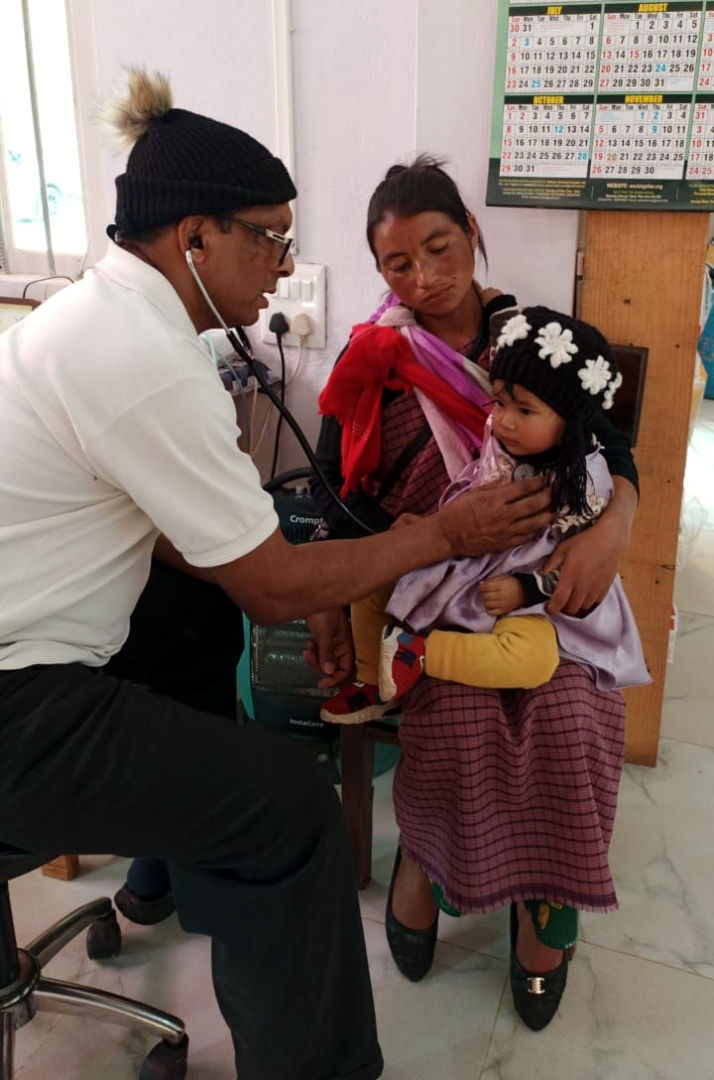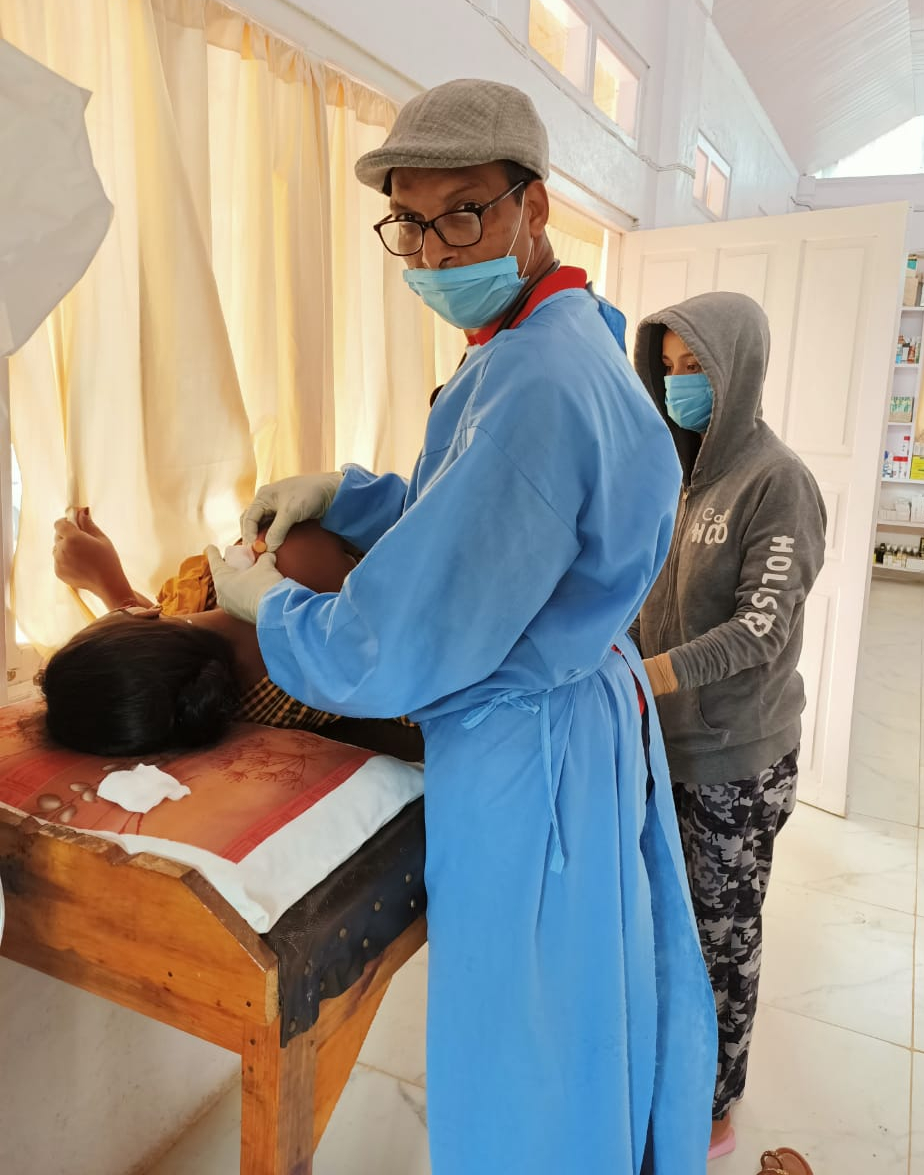
Fr Damaciano Fernandes treating a patient in his hospital at Mawlyntriang in West Khasi Hills district of Meghalaya.
Pilar missionaries Fr Jerry Fernandes from Guirim and Fr Damaciano Fernandes from Arambol launched a mission at Nongkhlaw in Meghalaya – ‘the Abode of Clouds’ under Nongstoin diocese on December 19, 2004, when a new parish St Francis Xavier was established and given to Pilar Fathers, which was bifurcated from St Thomas Parish at Mairang. ‘Megha’ means clouds and ‘alaya’ means abode. Meghalaya is a mysterious and enchanting land-locked hilly state in north-east India. The parishioners belong to Khasi and Gharo tribes and some are Nepalese and Assamese who are spread out in about 55 villages. The Catholic population is about 6,000. Presently, Fr Alfred Almeida, Fr Manohar Kata and Fr Peter Raja are serving in the parish and school and Fr Damaciano Fernandes is giving full-time service in a hospital built by him.

Fr Damaciano Fernandes and nurse Josephine Marngan treating a patient in his hospital at Mawlyntriang in West Khasi Hills district of Meghalaya.
INVOLVEMENT
In the initial stage, the two pioneers started visiting schoolchildren in their homes and discovered sick people suffering from various types of skin diseases. During their village rounds, they used to clean the affected skins of persons with soap and antiseptics, apply ointments and give antibiotics.
People were getting healed and were taken up by these cures and they informed others about the medical services of the Fathers. The patients started coming to the parish for medicine and a small room in the Fathers’ Residence was used as a clinic.
In the beginning, medicines were limited and space was small, but today, patients have a hospital at Mawlyntriang, 1 km away from the parish named St Xavier Holistic Health Centre opened in 2021 and served by 3 nurses, a pharmacist, Dr Bantista Wanniang and Fr Damaciano.
According to Fr Damaciano, the people realised the holistic touch of the Fathers in their approach i.e. healings, concern for the welfare of patients and their families and prayers over the patients. The local professional doctors lack this type of approach. The immediate relief from illness is because of the medicine taken in faith.
Sometimes, people bring the patients’ dresses and clothes of daily use for blessing. Later, these dresses and clothes blessed by the priests are worn by patients. Through continuous service to the poor and the simple people of the area, the Fathers have won their hearts.
But in the beginning, they were not well accepted due to their features. The local people are Mongoloids and have fair complexion and the Fathers are Caucasoid (South Indians) and have brown complexion. After witnessing Fathers’ dedicated services, the people welcomed them and now don’t want to lose them.
Pastors of Presbyterian Church and other denominations were envious of their ministry and wanted to challenge them. They were surprised as to how Goan missionaries could stay in their territories and work successfully, though coming from a faraway place. Conjectures about the Fathers were many and varied. They were treated as outsiders and not welcomed there.
INTERVENTION
Fr Damaciano told me that local people eat different types of insects and worms. Since they don’t take regular baths, they suffer from skin diseases. They regularly consume meat which is not properly cooked. Excessive worms are formed in their intestines and very often they get diarrhoea. Sometimes, the eggs of the worms reach their brain through the circulation of blood and this deteriorates their health. They consume tobacco and eat betel nuts, which lead to throat cancer.
Epilepsy is very common in that area due to malnutrition of the mothers during pregnancy. Constipation and piles are common ailments because they consume less water due to cold climate. Some local doctors send the patients to Fr Damaciano because his medicines are more effective.
Some medical practitioners used to go to his clinic for medical training and experience. Dr Faye Antao from Utorda went and stayed in his mission centre for 5 months. She said that the practical knowledge she got there was more than what she got in the medical college where she studied. She also said she got better knowledge of medicines there, which she could not get in her medical books.
Fr Damaciano realised that a missionary priest is not only for administration of Sacraments, but he has to be a master of all trades, especially in the areas where people lack medical and other facilities.
INSPIRATION
Fr Damaciano was inspired by the book, ‘Where there is no Doctor-A Health Care Handbook,’ written by David Werner, which motivated him to proceed with this medical service. He was also deeply inspired by Dr Albert Schweitzer, a missionary doctor who built a hospital and served the poor patients in Gabon in Africa and St Damien De Veuster who treated the lepers in Molokai in Hawaii.
Since Fr Damaciano has an inborn liking for health service, during his priestly studies at Pilar Seminary in Goa, he used to help in the infirmary. He received medical training from Dr Anil Gharse and Dr Arnold Fernandes from Agassaim, Dr Dhakankar and Dr Carmo Pegado from Goa Velha, Dr Tham in Shillong, Dr Adhim at Mairang in Meghalaya and Fatima Sisters’ dispensary at Wahlang in Meghalaya.
Later in 2012, he was trained at St John’s Medical College, Bangalore for 3 months. To keep his medical knowledge updated, he reads books which deal with Ayurvedic and allopathic medical treatment.
During my visit to Nongkhlaw in April 2013, I witnessed the miracles taking place in Fr Damaciano’s former clinic. Many patients come with sad faces because of their ailments but go back with a sigh of relief experiencing the gentle and healing touch of Fr Damaciano.
The healing touch, concern and love for the patients and the prayers over them are the magical tools used by this Goan missionary doctor in Meghalaya for his medical ministry.
[The writer is Director of Apostolic School & Assistant Parish Priest of St Francis Xavier Church, Hisar, Haryana]